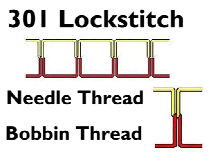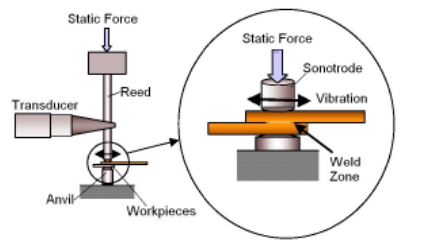
Standard Sewing vs. Ultrasonic Seaming
Standard Sewing vs. Ultrasonic Seaming
Sewing remains the most popular method of joining fabrics. The lockstitch machine is the standard method used for sewing. A bobbin sits in the middle of the shuttle, which is rotated in synch with the motion of the needle. The needle pulls a loop of thread through the fabric, rises, then reinserts into the fabric. The feed dogs are what move the fabric forward and through the machine. Instead of joining the different loops together as seen in chain stitching, the thread from the machine is joined with a separate spool of thread that is the bobbin. On the machine, a tension wheel is present. The tension must be at the appropriate setting in order for the stitch to form correctly. In a single inch of a seam there are usually 10 stitches per inch.


Disadvantages with traditional sewing include discontinuous joints producing perforated seams, sewing thread deteriorating over time, and speed limitations.
Ultrasonic sealing, as defined above, has several advantages for joining fabrics made from thermoplastic polymers or those containing thermoplastic fibers. The FS-90 machine requires no needles. This significantly reduces on waste generated because in traditional sewing, needles frequently break, causing waste. More money is also spent on replacing the needles. The absence of thread in ultrasonic sealing is also extremely beneficial. Because there is no presence of thread in garments that have been welded ultrasonically, there is no threat of thread deterioration over time. A large amount of material and waste is also reduced when thread is not used. This can be very beneficial for the environment, making ultrasonic sealing a ‘green’ technology. The technique also requires no solvents, adhesives or mechanical fasteners when joining two fabrics together. Ultrasonic sealing differs from thermal bonding in the sense that fiber degradation is minimized because heat energy is generated within the fibers using ultrasonic energy (Tolunay, Dawson et al. 1983; Mao and Goswami 1997). In thermal bonding, the heat energy is applied to the fibers in order to melt them. Seams created with ultrasonic sealing are impermeable, making the garments produced ideal for medical clothing that can be worn around contamination, parachutes and other products, such as boat sails that must have impermeable seams in order to function (Benatar and Gutowski 1986; Benatar and Gutowski1989). Ultrasonic sealing of non-woven thermoplastic fibers is based on the ultrasonic welding of metal that was first discovered in the 1960’s. Although the materials joined are different, the same mechanisms of operation exist to create a bond.

The process of ultrasonic welding involves 4 key components. The power supply converts a standard electrical signal into an ultrasonic frequency, usually of the order of 20 kHz. A transducer converts the electrical energy into mechanical vibratory energy, which is amplified and transmitted to the workpiece by a sonotrode. When a joint is made, a clamping force combined with vibration cause a localized heating affect at the interface of the 2 materials and a bond forms (Benatar and Gutowski 1986; Benatar and Gutowski 1989; Wright, Prangnell et al. 2009). The absence of heating elements, or the need for cooling and extremely low tooling costs make this process very cost effective when compared to other joining methods.
© Copyright: 2024 Hangzhou Altrasonic Technology Co.,Ltd All Rights Reserved

IPv6 network supported
Scan to wechat
